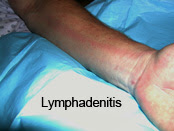Lymphangitis & Lymphadenitis
General Considerations
Lymphangitis and lymphadenitis are common manifestations of
a bacterial infection that is usually caused by hemolytic streptococci or
staphylococci (or by both organisms) and usually arises from an area of
cellulitis, generally at the site of an infected wound. The wound may be very
small or superficial, or an established abscess may be present, feeding bacteria
into the lymphatics. The involvement of the lymphatics is often manifested by a
red streak in the skin extending in the direction of the regional lymph nodes,
which are, in turn, generally tender and engorged. Systemic manifestations
include fever, chills, and malaise. The infection may progress rapidly, often in
a matter of hours, and may lead to septicemia and even death.
Clinical Findings
 |
| credit image for http://www.ecellulitis.com/useful/cellulitis-complications/ |
Symptoms and Signs
Throbbing pain is usually present in the area of cellulitis
at the site of bacterial invasion. Malaise, anorexia, sweating, chills, and
fever of 37.8–40 °C develop rapidly. The red streak, when present may be
definite or may be very faint and easily missed, especially in dark-skinned
patients. It is usually tender or indurated in the area of cellulitis. The
involved regional lymph nodes may be significantly enlarged and are usually
quite tender. The pulse is often rapid.
Laboratory Findings
Leukocytosis with a left shift is usually present. Later,
blood cultures may be positive, most often for staphylococcal or streptococcal
species. Culture and sensitivity studies of the wound exudate or pus may be
helpful in treatment of the more severe or refractory infections but are often
difficult to interpret because of skin contaminants.
Differential Diagnosis
Lymphagitis may be confused with superficial
thrombophlebitis, but the erythema and induration of thrombophlebitis is
localized in and around the thrombosed vein. Venous thrombosis is not associated
with lymphadenitis, and a wound of entrance with secondary cellulitis is
generally absent. Superficial thrombophlebitis frequently arises as a result of
intravenous therapy, particularly when the needle or catheter is left in place
for more than 2 days; if bacteria have also been introduced, suppurative
thrombophlebitis may develop.
Cat-scratch fever should be considered when lymphadenitis
is present; the nodes, though often very large, are relatively nontender.
Exposure to cats is common, but the patient may have forgotten about the
scratch.
It is extremely important to differentiate cellulitis from
acute streptococcal hemolytic gangrene, necrotizing fascitiis, gram-negative
anaerobic cutaneous gangrene, and progressive bacterial synergistic gangrene.
These are deeper infections that may be extensive and are potentially lethal.
Patients appear more seriously ill; there may be redness due to leakage of red
cells, creating a non-blanching erythema; and subcutaneous crepitus may be
palpated or auscultated using the diaphragm with light pressure over the
involved area. Immediate wide debridement of all involved deep tissues should be
done if these signs are present.
Treatment
General Measures
Prompt treatment should include heat (hot, moist compresses
or heating pad), elevation when feasible, and immobilization of the infected
area. Analgesics may be prescribed for pain.
Specific Measures
Antibiotic therapy should always be instituted when local
infection becomes invasive, as manifested by cellulitis and lymphangitis.
Because such infections are so frequently caused by streptococci, cephalosporins
or extended-spectrum penicillins are commonly used. Given the increasing
incidence of methicillin-resistant Staphylococcus aureus (MRSA) in the
community, coverage of this pathogen with appropriate antibiotic therapy should
be considered.
Wound Care
Drainage of pus from an infected wound should be carried
out, generally after the above measures have been instituted and only when it is
clear that there in an abscess associated with the site of initial infection.
There is no value in incising areas of cellulitis if there is no abscess to be
drained.
Prognosis
With proper therapy particularly an antibiotic effective
against the invading bacteria, control of the infection can usually be achieved
in a few days. Delayed or inadequate therapy can still lead to overwhelming
infection with septicemia.